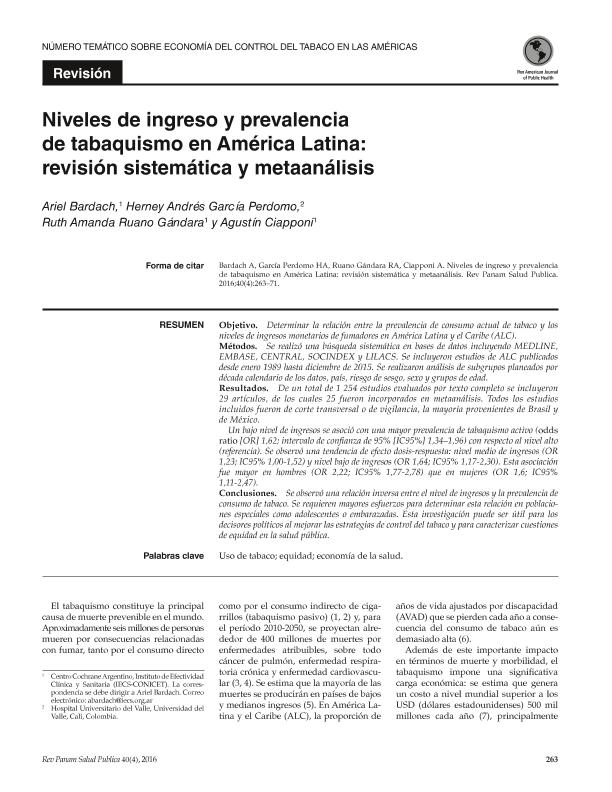Mostrar el registro sencillo del ítem
dc.contributor.author
Bardach, Ariel Esteban

dc.contributor.author
García Perdomo, Herney Andrés
dc.contributor.author
Ruano Gandara, Ruth Amanda

dc.contributor.author
Ciapponi, Agustín

dc.date.available
2018-07-25T19:06:19Z
dc.date.issued
2016-07
dc.identifier.citation
Bardach, Ariel Esteban; García Perdomo, Herney Andrés; Ruano Gandara, Ruth Amanda; Ciapponi, Agustín; Niveles de ingreso y prevalencia de tabaquismo en América Latina: revisión sistemática y metaanálisis; Pan American Health Organization; Revista Panamericana de Salud Pública; 40; 4; 7-2016; 263-271
dc.identifier.issn
1020-4989
dc.identifier.uri
http://hdl.handle.net/11336/53125
dc.description.abstract
Objective. Determine the relationship between the prevalence of current tobacco use and smoker income levels in Latin America and the Caribbean (LAC). Methods. A systematic search was conducted in MEDLINE, EMBASE, CENTRAL, SOCINDEX, and LILACS databases. Studies from LAC published from January 1989 to December 2015 were included and analyzed by subgroups disaggregated by decade of data, country, bias risk, sex, and age group. Results. Of 1,254 studies evaluated by full text, 29 articles were included, of which 25 were chosen for meta-analysis. All included studies were cross-sectional or surveillance, and were primarily from Brazil and Mexico. Low income was associated with a higher prevalence of active tobacco use (odds ratio [OR] 1.62; 95% confidence interval [95% CI] 1.34–1.96 than high income (reference). A dose-response effect trend was observed: middle income (OR 1.23; 95% CI 1.00-1.52) and low income (OR 1.64; 95% CI 1.17-2.30). This association was greater in men (OR 2.22; 95% CI 1.77- 2.78) than in women (OR 1.6; 95% CI 1.11-2.47). Conclusions. An inverse relationship was observed between income and tobacco use prevalence. Further efforts are required to determine this relationship in special populations, such as adolescents and pregnant women. This research may be useful to policymakers by improving tobacco control strategies and characterizing public health equity issues.
dc.description.abstract
Objective
Determine the relationship between tobacco-use prevalence and smoker income level in Latin America and the Caribbean (LAC).
Methods
A systematic search was carried out in MEDLINE, EMBASE, CENTRAL, SOCINDEX, and LILACS databases. Studies from LAC published from January 1989 to December 2015 were included and were analyzed by subgroups disaggregated by decade of data, country, bias risk, sex, and age group.
Results
Of 1 254 studies evaluated by full text, 29 articles were included, of which 25 were chosen for meta-analysis. All included studies were cross-sectional or surveillance, primarily from Brazil and Mexico. Low income was associated with higher prevalence of active smoking (odds ratio [OR] 1.62; 95% confidence interval [95%CI] 1.34–1.96) than high income (reference). A dose-response effect trend was observed: middle income (OR 1.23; 95%CI 1.00-1.52) and low income (OR 1.64; 95%CI 1.17-2.30). This association was greater in men (OR 2.22; 95%CI 1.77-2.78) than in women (OR 1.6; 95%CI 1.11-2.47).
Conclusions
An inverse relationship was observed between income and tobacco-use prevalence. Further efforts are required to determine this relationship in special populations, such as adolescents and pregnant women. This research can be useful for policymakers by improving tobacco control strategies and for characterizing public health equity issues.
dc.format
application/pdf
dc.language.iso
spa
dc.publisher
Pan American Health Organization
dc.rights
info:eu-repo/semantics/openAccess
dc.rights.uri
https://creativecommons.org/licenses/by-nc-sa/2.5/ar/
dc.subject
Tabaquismo
dc.subject
América Latina
dc.subject.classification
Salud Ocupacional

dc.subject.classification
Ciencias de la Salud

dc.subject.classification
CIENCIAS MÉDICAS Y DE LA SALUD

dc.title
Niveles de ingreso y prevalencia de tabaquismo en América Latina: revisión sistemática y metaanálisis
dc.title
Income and smoking prevalence in Latin America: a systematic review and meta-analysis
dc.type
info:eu-repo/semantics/article
dc.type
info:ar-repo/semantics/artículo
dc.type
info:eu-repo/semantics/publishedVersion
dc.date.updated
2018-07-25T13:57:10Z
dc.journal.volume
40
dc.journal.number
4
dc.journal.pagination
263-271
dc.journal.pais
Brasil

dc.journal.ciudad
Sao Paulo
dc.description.fil
Fil: Bardach, Ariel Esteban. Consejo Nacional de Investigaciones Científicas y Técnicas; Argentina. Instituto de Efectividad Clínica y Sanitaria; Argentina
dc.description.fil
Fil: García Perdomo, Herney Andrés. Universidad del Valle, California; Estados Unidos
dc.description.fil
Fil: Ruano Gandara, Ruth Amanda. Instituto de Efectividad Clínica y Sanitaria; Argentina
dc.description.fil
Fil: Ciapponi, Agustín. Instituto de Efectividad Clínica y Sanitaria; Argentina. Consejo Nacional de Investigaciones Científicas y Técnicas; Argentina
dc.journal.title
Revista Panamericana de Salud Pública

dc.relation.alternativeid
info:eu-repo/semantics/altIdentifier/url/https://www.scielosp.org/scielo.php?script=sci_arttext&pid=S1020-49892016001000263
dc.relation.alternativeid
info:eu-repo/semantics/altIdentifier/url/http://www.paho.org/Project.asp?SEL=PR&LNG=ENG&CD=journal
Archivos asociados
